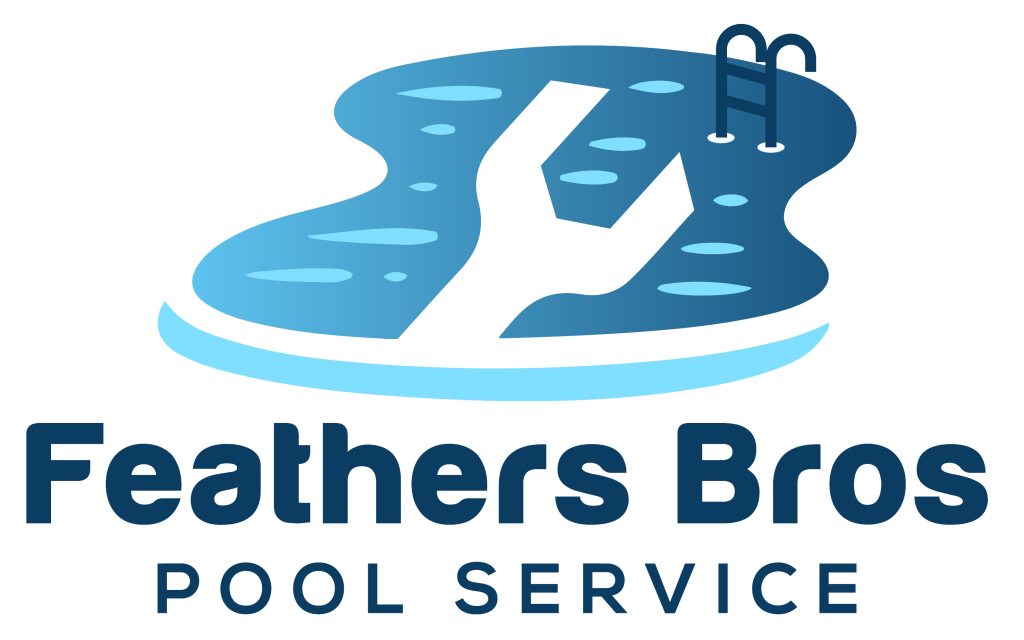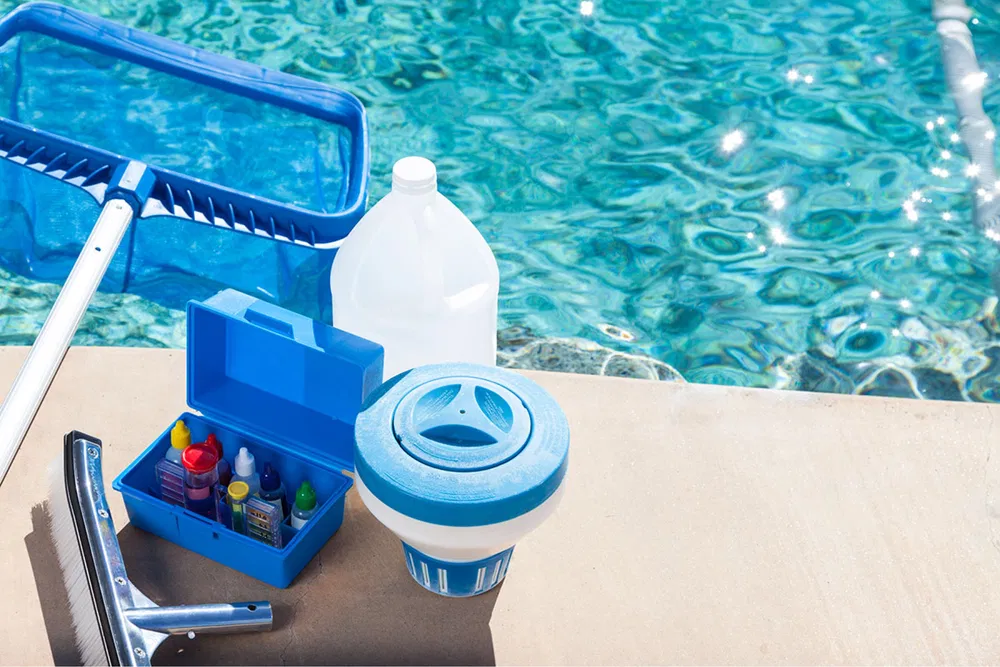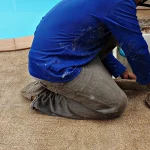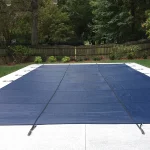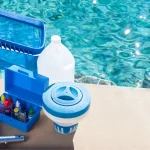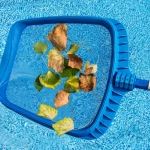A sparkling, crystal-clear pool doesn’t just happen by accident. It’s the result of careful maintenance, especially when it comes to water chemistry. Balancing chemicals in pool water is one of the most important responsibilities of a pool owner. Without the right balance, you risk more than just cloudy water. Unbalanced water can cause algae growth, skin and eye irritation, and even damage to your pool’s equipment and surfaces. As the Best Pool Care Company, Feathers Bros Pool Service understands how overwhelming chemical balancing can seem at first. That’s why we’ve put together this complete homeowner’s guide to help you keep your water clean, safe, and perfectly balanced all season long.
Why Balancing Chemicals in Pool Matters
Balancing chemicals in pool water isn’t simply about making it look good. It’s about creating a safe swimming environment while protecting your investment. Water that’s too acidic can corrode ladders, liners, and pumps, and water that’s too alkaline can lead to scale buildup and cloudy conditions. Additionally, if sanitizers like chlorine aren’t at the right level, bacteria and algae can multiply quickly, making your pool unsafe.
Professional Pool Chemical Balancing in Indianapolis, IN ensures that your pH, alkalinity, sanitizer, and calcium hardness levels all work in harmony. This balance not only keeps swimmers comfortable but also extends the lifespan of your pool equipment.
Key Elements of Pool Water Chemistry
When you’re learning about balancing chemicals in pool water, there are five key elements you’ll need to monitor regularly:
pH Level: These measures how acidic or basic your water is. The ideal range is between 7.4 and 7.6. If your pH drops too low, the water becomes corrosive. If it rises too high, chlorine becomes less effective.
Total Alkalinity (TA): Alkalinity acts as a buffer for pH, preventing sudden changes. The recommended range is 80–120 ppm.
Chlorine: This is your primary sanitizer, killing bacteria and algae. Maintain levels between 1–3 ppm for optimal safety.
Calcium Hardness: This measures the amount of dissolved calcium in the water. Low levels can cause plaster to erode, while high levels lead to scaling. Aim for 200–400 ppm.
Cyanuric Acid (Stabilizer): This protects chlorine from being destroyed by sunlight. Ideal levels are 30–50 ppm.
Each of these elements works together. If one is out of balance, it can affect the others, which is why regular testing and adjustments are so important.
Step-by-Step Process for Balancing Chemicals in Pool
Balancing your pool’s water chemistry isn’t complicated if you follow a consistent routine. Here’s a process you can use to keep everything in check:
- Test the Water Regularly: Use a reliable testing kit or digital meter to check pH, alkalinity, chlorine, calcium hardness, and stabilizer levels. We recommend testing at least once a week during the swimming season.
- Adjust Alkalinity First: If your alkalinity is out of range, fix this before anything else. Add baking soda to raise it or use muriatic acid to lower it. This step stabilizes your pH.
- Set the pH Level: Once alkalinity is correct, adjust pH by adding soda ash to raise it or muriatic acid to lower it.
- Sanitize with Chlorine: Keep chlorine levels within the recommended range to prevent bacteria and algae growth. Consider using stabilized chlorine if your pool gets a lot of sunlight.
- Balance Calcium Hardness: Add calcium chloride to increase hardness if levels are too low. If levels are too high, partially drain and refill the pool with fresh water.
- Maintain Cyanuric Acid – If levels are low, add stabilizer. If too high, dilute by replacing some of the water.
- Re-Test and Fine-Tune: After adjustments, retest the water to ensure everything is in the correct range.
For homeowners who don’t have the time or want guaranteed results, professional Pool Chemical Balancing in Indianapolis, IN by Feathers Bros Pool Service can handle this entire process for you.
Signs Your Pool Chemicals Are Out of Balance
If you’re not testing your water regularly, your pool will eventually show signs of chemical imbalance. Some common indicators include:
- Cloudy or murky water
- Algae growth on walls or steps
- Strong chlorine smell (ironically, this often means chlorine is too low)
- Eye or skin irritation after swimming
- Scaling on tiles or equipment
- Rust or corrosion on ladders, rails, or fixtures
Catching these issues early can save you from costly repairs and extra cleaning.
Professional Help for Balancing Chemicals in Pool
While DIY testing and adjustments are possible, many homeowners find that working with professionals is the easiest and most reliable way to keep their pool water perfect. As the Best Pool Care Company in Indianapolis, Feathers Bros Pool Service offers expert testing, precise chemical adjustments, and regular maintenance so you can enjoy your pool without the stress. We use commercial-grade equipment and high-quality chemicals to ensure your water stays safe, comfortable, and crystal clear all season.
Seasonal Tips for Balancing Pool Chemicals
Spring Opening: When opening your pool, shock the water with chlorine, adjust alkalinity and pH, and make sure calcium hardness is in range before the season begins.
Summer Maintenance: Test weekly and adjust as needed. Hot weather, heavy use, and rain can all affect chemical levels.
Fall Closing: Before closing, balance all chemicals, shock the pool, and lower water levels. This prevents damage and algae growth during the off-season.
These seasonal steps are part of why ongoing Pool Chemical Balancing in Indianapolis, IN is so important. It keeps your water safe year-round.
FAQs
- How often should I test my pool’s water?
You should test your pool’s water at least once a week during swimming season. If your pool gets heavy use or after heavy rain, test more often. - Can I swim in my pool right after adding chemicals?
It depends on the chemical. Some, like chlorine shock, require waiting at least 24 hours, while others, like pH adjusters, may only need a few hours. Always read product labels. - What happens if my pH is too high?
If pH is too high, chlorine becomes less effective, and you may notice cloudy water or scaling. Lower it using muriatic acid or sodium bisulfate. - Is professional pool chemical balancing worth it?
Yes, especially if you want consistent, safe, and accurate results without the hassle of frequent testing and adjustments. - What’s the fastest way to clear cloudy water?
Check and adjust your pH and chlorine first. If levels are correct, consider adding a clarifier or performing a shock treatment.
Conclusion
Balancing chemicals in pool water is the foundation of a safe, enjoyable swimming experience. By maintaining proper levels of pH, alkalinity, sanitizer, calcium hardness, and stabilizer, you can protect your pool, keep swimmers comfortable, and ensure clear, sparkling water. Whether you prefer to handle chemical balancing yourself or let the Best Pool Care Company in Indianapolis take care of it, the key is consistency. For hassle-free maintenance and expert results, Feathers Bros Pool Service is here to help.
